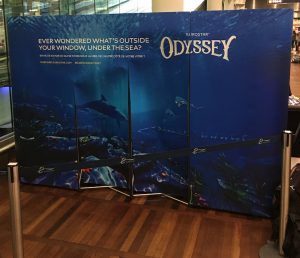
The debate rages on as to whether the future lies with Augmented Reality (AR) or Virtual Reality (VR)? Or will it be more about Mixed Reality (including 360˚)? In any event, as far as VR is concerned, we continue to see experiments with more or less success. Hitches in the development of VR typically include meek visual storytelling, technological hiccoughs/bugs and, still, weak consumer awareness. Eurostar recently launched its VR experience, Eurostar Odyssey, to entertain its passengers during the 2+ hour journey between France and England. Being a Eurostar fanboy and geek, I had to try it out.
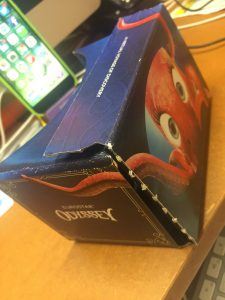
The cardboard “Virtual Reality” headset
Eurostar Odyssey – The Experience
The cardboard headset I received was from the Eurostar back office, before they were made available to the general public. As such, my headset had a bit of wear and tear, but was otherwise fully functional. Once I was onboard, I immediately signed up for the onboard wifi as, to check it out, you actually need to be on board and in the Eurostar app (or website) to use it. N.B, In the train station, the onboard wifi is distinctly more effective. I loaded up the app on my smartphone and then dutifully slotted the phone into the headset. Here were a few of my thoughts and reactions:
 The set up requires you to input in which seat you’re sitting (ie in which direction you are facing). Having done so, I found it peculiar as the fish were all in the aisle… I then input a different seat direction and had the fish outside the window where I expected to find them!
The set up requires you to input in which seat you’re sitting (ie in which direction you are facing). Having done so, I found it peculiar as the fish were all in the aisle… I then input a different seat direction and had the fish outside the window where I expected to find them!- Since the wifi onboard remains spotty and/or slow (and being onboard with wifi connection is a condition sine qua non), there are inevitable blips in connection. And, for international travellers who rely on the wifi to avoid roaming charges, this is a major hurdle still to overcome.
- The method of selecting an object (fish, shipwreck…) to find out more about involves keeping your red dot (in the middle of the screen) primed on a target. Then that target will migrate in front of you and you can learn more about it. Not too bad a system. You can even scoop multiple targets.
- If you don’t have the headset (that option exists), you just use your smartphone. This makes the app seem more like Augmented Reality rather than Virtual Reality.
- There is no audio which would certainly make the experience far more immersive.
- The stories and content is fine (for an adult).
Eurostar Odyssey by Eurostar Odyssey
I note that Eurostar released a video on Youtube end of July (see their site)
And for the kids?
Not satisfied with my own ‘adult’ feedback, I sought out some kids to see what they thought. A few rows up, I found a vulnerable set of parents with two youngsters. In that I had only one kit, there was a risk that VR-envy would settle in for the one who was “left out.” Notwithstanding that inevitable fact, I gained a few elements of feedback from the American father (more on him later*) and his two daughters (roughly 7 and 9 years old).
- With his American smartphone and with the train hurtling at 300 kmh, the wifi failed dismally. I ended up having to loan them my own local smartphone.
- Once properly loaded up, the kids alternated and spent about 15 minutes each exploring the underwater Odyssey experience.
- One shy daughter said about it: “yeah, it was good.” Not overwhelming enthusiasm though.
- The father gave a probably higher thumbs up as it did occupy the kids for a while; albeit when one was using the headset, the other was requiring compensatory attention!
Bottom Line?
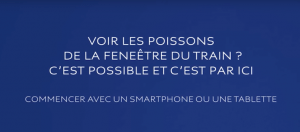
Replete with an error (in French) in the corporate video…. Can you spot the mistake?
When an organisation invests in one or other “new tech” initiative, the key to evaluating its success lies truly in understanding the strategic intent behind it. Without knowledge of that intent, the outside observer that I am says that the Eurostar Odyssey VR experience represents a reasonably logical idea: educational entertainment (“edutainment”) for its kid passengers that will potentially relieve the parents and surrounding passengers. If the objective is to show off Eurostar’s innovative bent, I would say that getting a fully functioning wifi should be higher up the priority list… and I’m still quite unsatisfied by the design of the new Eurostar trains, as I have written before.
The Future of Virtual Reality…
In my upcoming book, Futureproof, my co-author Caleb Storkey and I debated over many coffees whether or not Virtual Reality and Augmented Reality merited their own chapter. While there will be some extraordinary opportunities with VR for its emotional and immersive experience (in health, education, entertainment…), we chose NOT to include a focus on these technologies. The main reasons are that (a) VR has still many technical and UX issues to overcome and (b) the headset is far too cumbersome. Moreover, the storytelling capabilities are far from honed. I think we will see much more VR emerging in the 2020s — but in different formats. In the meantime, it seems more likely that AR will find greater uptake.
Your thoughts are welcome as ever!
*It turns out that the individual I approached so seemingly randomly is someone who knew my name for having worked with Traackr in the past! Too funny. Proof that serendipity will lead to unexpected and great discoveries!

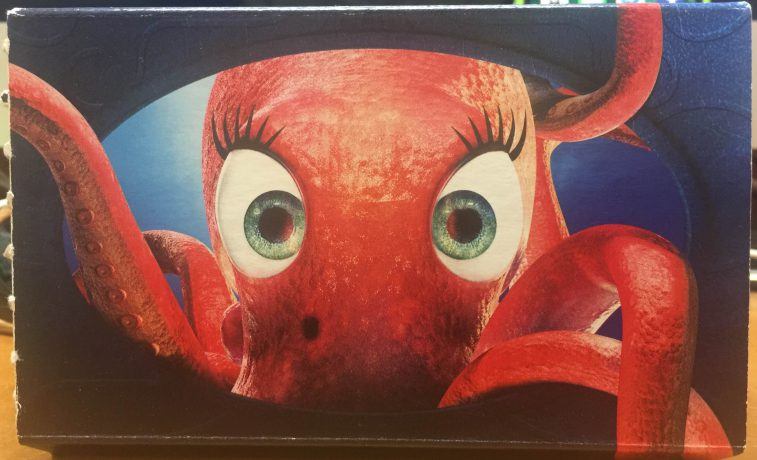
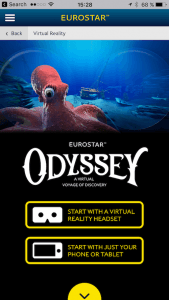 The set up requires you to input in which seat you’re sitting (ie in which direction you are facing). Having done so, I found it peculiar as the fish were all in the aisle… I then input a different seat direction and had the fish outside the window where I expected to find them!
The set up requires you to input in which seat you’re sitting (ie in which direction you are facing). Having done so, I found it peculiar as the fish were all in the aisle… I then input a different seat direction and had the fish outside the window where I expected to find them!








